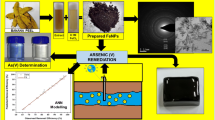Abstract
Biosolids are the treated organic residuals, also known as sludge, that are generated from domestic wastewater treatment plants. According to the USEPA, over 7 millions tons (dry weight) of biosolids are generated every year in the US by more than the 16,000 wastewater treatment plants and a large portion of these biosolids is disposed on land. Nuisance odors, the potential of pathogen transmission, and presence of toxic and persistent organic chemicals and metals in biosolids have for the most part limited the use of land applications. This paper presents zero-valent iron nanoparticles (1–100 nm) for the treatment and stabilization of biosolids. Iron nanoparticles have been shown to form stable and nonvolatile surface complexes with malodorous sulfur compounds such as hydrogen sulfide and methyl sulfides, degrade persistent organic pollutants such as PCBs and chlorinated pesticides, and sequestrate toxic metal ions such as mercury and lead. The end products from the nanoparticle reactions are iron oxides and oxyhydroxides, similar to the ubiquitous iron minerals in the environment. Due to the large surface area and high surface reactivity, only a relatively low dose (<0.1% wt) of iron nanoparticles is needed for effective biosolids stabilization. The iron nanoparticle technology may thus offer an economically and environmentally sustainable and unique solution to one of the most vexing environmental problems.
Similar content being viewed by others
References
Bard A.J. & L.R. Faulkner, 2000. Electrochemical Methods: Fundamentals and Applications, 2nd edn. John Wiley & Sons, Inc
Cao J., Zhang W. (2006) Reduction and immobilization of hexavalent chromium by nanoscale iron particle. J. Hazardous Mater. 132:213–218
Dzombak D.A. & F.M.M. Morel, 1990. Surface Complexation Modeling. Wiley-Interscience
Elliott D., Zhang W. (2001) Field assessment of nanoscale bimetallic particles for groundwater treatment. Environ. Sci. Technol. 35:4922–4926
Federal, 1993. 40 CFR Part 503, Standards for the Disposal of Sewage Sludge
Li X., Zhang W. (2006) Iron nanoparticles: the core-shell structure and unique properties for Ni(II) sequestration. Langmuir 22:4638–4642
Li X.Q., D.W. Elliot & W.X. Zhang, 2006. Zero-valent iron nanoparticles for abatement of environmental pollutants: Materials and Engineering aspects. Critic. Rev. Solid State Mater. Sci. 31:111–122
Lien H., Zhang W. (1999) Reactions of chlorinated methanes with nanoscale metal particles in aqueous solutions. J. Environ. Eng. 125:1042–1047
Lien H., Zhang W. (2001) Complete dechlorination of chlorinated ethenes with nanoparticles. Colloids Surfaces A 191:97–105
McFraland M.J (2000) Biosolids Engineering. McGraw-Hill, New York
Metcalf & Eddy, 2003. Wastewater Engineering, Treatment and Reuse, 4th edn. McGraw Hill.
National Research Council, 2002. Biosolids Applied to Land: Advancing Standards and Practices
Ponder S.M., Darab J.G., Mallouk T.E. (2000) Remediation of Cr(VI) and Pb(II) aqueous solutions using supported, nanoscale zero-valent iron. Environ. Sci. Technol. 34:2564–2569
Speece R.E. (1996) Anaerobic Biotechnology for Industrial Wastewaters. Nashville, Archae Press
Sun Y.P, Li X., Cao J., Zhang W., Wang H.P. (2006) Characterization of zero-valent iron nanoparticles. Adv. Colloid Interfac. 120:47–56
Stumm W. & J.J. Morgan, 1996. Aquatic Chemistry, 3rd edn. John Wiley & Sons, Inc
Stumm W., 1992. Chemistry of the Solid–Water Interface. Wiley-Interscience.
Tchobanoglous G., H. Theisen & S. Vigil, 1993. Integrated Solid Waste Management. McGraw Hill
United States Environmental Protection Agency (USEPA), 1979. Process Design Manual for Sludge Treatment and Disposal. Washington, DC
United States Environmental Protection Agency (USEPA), 1993. Standards for the Use or Disposal of Sewage Sludge. Washington, DC
United States Environmental Protection Agency (USEPA), 1999. Biosolids Generation, Use, and Disposal in the United States U.S. Municipal and Industrial Solid Waste, Division Office of Solid Waste EPA530-R-99–009
United States Environmental Protection Agency (USEPA), 2000a. Biosolids Technology Fact Sheet: Alkaline Stabilization of Biosolids. Office of Water, EPA 832-F-00–052. Washington, DC
United States Environmental Protection Agency (USEPA), 2000b. Land Application of Biosolids Management. EPA 832-F-00–064. Washington, DC
United States Environmental Protection Agency (USEPA), 2000c. Odor Management in Biosolids Management. EPA 832-F-00–067. Washington, DC
United States Environmental Protection Agency (USEPA), 2003. Control of Pathogens and Vector Attraction in Sewage Sludge. EPA 625-R-92–013, Revised July (2003), Washington, DC
Wang C.B., Zhang W.X. (1997) Synthesizing nanoscale iron particles for rapid and complete dechlorination of TCE and PCBs. Environ. Sci. Technol. 31(7):2154–2156
Zhang W.X., Wang C.B., Lien H.L. (1998) Treatment of chlorinated organic contaminants with nanoscale bimetallic particles. Catal. Today 40(4):387–395
Zhang W. (2003) Nanoscale iron particles for environmental remediation: an overview. J. Nanoparticle Res. 5:323–332
Acknowledgments
This research is partially supported by USEPA STAR grants (R829624 and GR832225).
Author information
Authors and Affiliations
Corresponding author
Rights and permissions
About this article
Cite this article
Li, Xq., Brown, D.G. & Zhang, Wx. Stabilization of biosolids with nanoscale zero-valent iron (nZVI). J Nanopart Res 9, 233–243 (2007). https://doi.org/10.1007/s11051-006-9187-1
Received:
Accepted:
Published:
Issue Date:
DOI: https://doi.org/10.1007/s11051-006-9187-1




